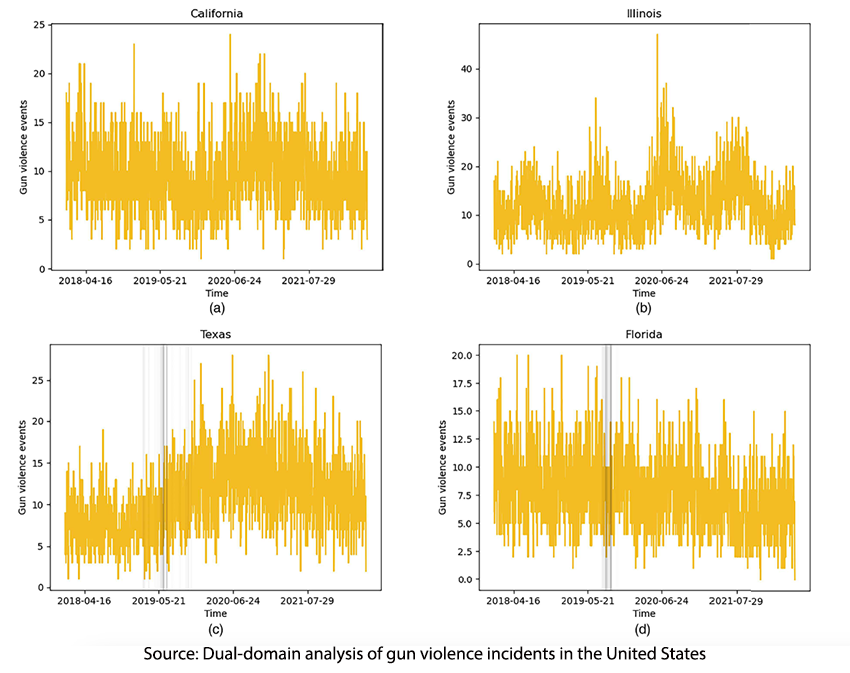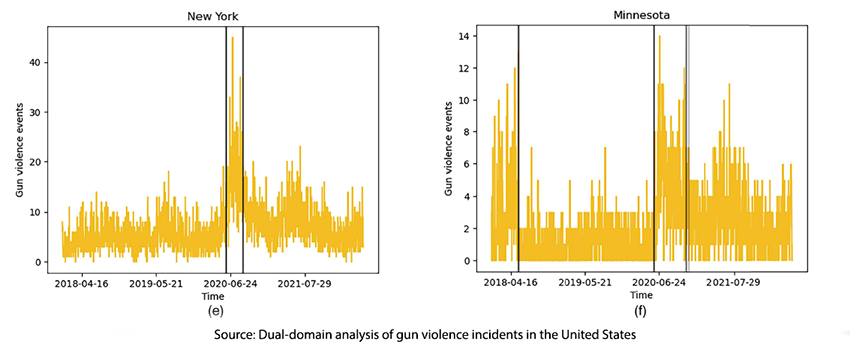Many news events are associated with upticks in gun violence. But underneath those national aggregates, we find a great deal of variation, as seen in this study from the journal Chaos. It's not that gun violence isn't increasing overall, but more that in some areas shootings rise while in others they fall.
The data comes from the Gun Violence Archives, “an online archive of gun violence incidents collected from over 7,500 law enforcement, media, government, and commercial sources.” It is not an advocacy group, but in the truest sense, it simply reports and lets you decide. The researchers took the data and created spatial, by state, and temporal, over time, analyses of the gun violence incidents reported. With both characterizations, they could overlay significant new events to look at their effect on these trends. The data set ran from January 2018 to June 2022
Here are the timelines of gun violence for four states.
Both California and Illinois show a periodic increase and decrease in gun violence without any reference to new or political events. In comparison, Texas and Florida show a change around late May 2019, but in opposite directions – gun violence increasing in Texas, with an accelerating decrease in Florida. Two states demonstrated spikes in gun violence in the summer of 2020, timing “consistent with a broad rise in U.S. crime and unrest in the wake of COVID-19.”
“… we have uncovered numerous observations that challenge widely held reporting on U.S. gun violence in recent years. First, it is notable that Minnesota, where George Floyd was killed and arguably the epicenter of the 2020 racial justice protests, exhibited the single greatest shift in its amplitude-adjusted periodic behaviors after April 2020. Next, we have identified numerous states with a “2020 summer jump” in gun violence, as widely discussed by the national media but have shown that this was far from uniform across states. While Minnesota, New York, Ohio, and Michigan exhibited such summer jumps, Texas exhibited a rise in gun incidence that took place well before 2020, while Florida has exhibited a welcome and continual decline, also initiated before 2020.” [emphasis added]
Aggregating data makes for large numbers and headlines, but it often obscures variation that provides a more nuanced context. It is easier for the media to report the aggregate, get the attention they desire and not have to try and communicate nuance. It is not that the aggregate is false nor necessarily misleading, but it often fails to tell the complete story. With gun violence, as with many actions that involve human behavior, the narrative is not a simple A resulting in B. As a science-curious reader, you need to look more deeply than what the aggregate tells us; the variation within is often a more important story to discern.
Source: Dual-domain analysis of gun violence incidents in the United States Chaos DOI: 10.1063/5.0120822



